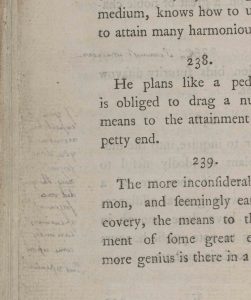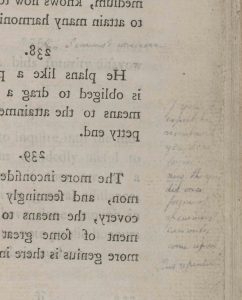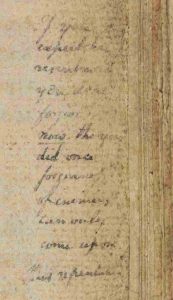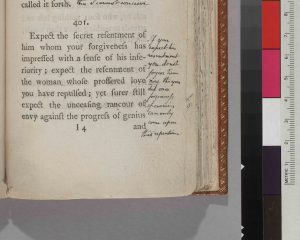So the marginalia group have been slowly plugging away at the transcriptions for the Lavater, Watson and Thornton books, and we’re in a fair way to finishing them soon. But there are a few oddities that we need to make a decision about, and one of them appears on page 82 of Lavater’s Aphorisms on Man.
One of the early decisions that was made about the Blake marginalia was not to transcribe any pages that did not contain Blake’s writing, and we’ve been fairly rigorous about this. Page 82 always had a question mark beside it, though, because: a) there is clearly marginal writing, b) it looks somewhat like Blake’s writing, but c) it’s written mirror-fashion, i.e. backwards. It didn’t take a lot of detective work to figure out that this writing must be an imprint from another piece of paper which was laid face down across the page, and that the ink accidentally bled through, leaving the backwards text. Does this count as marginalia? If it’s obviously accidental, is it more like the ink blots we found on other pages of the Lavater, which we are definitely not transcribing?
On the other hand, it is text, and it is somewhat legible, and the Blake Archive rules are to transcribe what you see. By the way, this is what you can see:

So we decided that this warranted some sort of investigation. Neither Erdman’s The Complete Poetry & Prose of William Blake nor Bentley’s Blake Books make a note of these annotations when discussing the Lavater marginalia. But we have the wonders of Photoshop, and I used it to horizontally flip the image:

Immediately more legible! Although this raises another question of whether we can reasonably expect Blake Archive users to read the backwards text without resorting to tricks like this, and if not, whether we’re justified in transcribing ‘what we can see.’ Especially since I also applied some Brightness/Contrast and Hue/Saturation adjustments in an attempt to make the text more clearly visible (although this didn’t actually produce much in the way of results; I have limited Photoshop skills).
My best version of the first annotation:

Then I tried to transcribe it, which was a rather dispiriting experience. Possibly ‘The Scavenes were cere’? Probably not. Thankfully, the second annotation was already clearer:

Which offered much more in the way of actually distinguishable words, namely:
I you
expect —
-esent–
you —
forgive
now the you
did once
forgiveness
of enemies
— only
come upon
this repent—–
So now I had something approaching an actual transcription, which was very exciting. And what was more satisfying — the last few months of painstakingly going through the completed transcriptions again and again whenever we made a change to the schema, had really paid off. I recognized the lines. And I was positive that I had read them on some other page in the Lavater. Prepared to go through all 210 if I had to, I started searching through the transcriptions of the other Lavater pages, and found that exact same annotation on page 135.

It was so much easier to read from this image. The actual transcription is:
this I cannot concieve
If you
respect his
resentment
you do not
forgive him
now tho you
did once
forgiveness
of enemies
can only
come upon
their repentance
There is nothing very extraordinary about the content of these annotations (Blake is commenting on two of the aphorisms) or their placement (as usual, he writes his comments next to the typographic text) but I cannot for the life of me figure out how these annotations became reverse-imprinted on page 82 of the same book. If they had been written on page 83, it would have made perfect sense — the book was closed too quickly after writing, and the wet ink bled through the facing page to form a mirror impression of the words.
But there are fifty-three pages between the original annotation and the imprint. And we would have noticed if the ink had somehow bled through all fifty-three pages. Were the others temporarily crumpled up in the middle? Were these two pages somehow temporarily touching long enough to leave the impression? Did Blake write out his annotations on another piece of paper and leave it face down on page 82, and then copy it onto the correct page? Probably not. And maybe there’s a really obvious answer that I’m just missing for some reason.
Either way, we still need to make a decision on what to do with this annotation — it’s Blake, it’s marginalia, and therefore we should transcribe it, right? And transcribe it backwards.

I agree–the word is definitely “expect.”
Great work, but surely “If you / expect his / resentment…”, with “expect” rather than “respect” being in keeping with what the comment relates to.